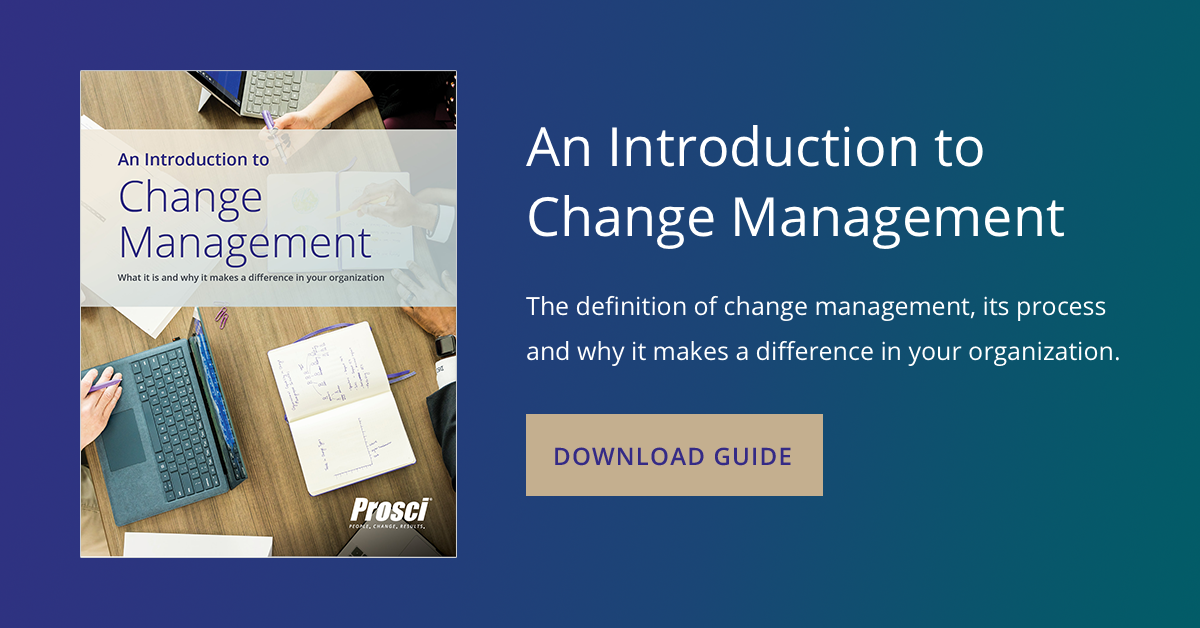The Case for Change Management: Results and Outcomes

3 Mins
Updated: August 5, 2024
Published: January 5, 2022

Year after year, participants in Prosci's benchmarking studies identify greater recognition of the need for and value of change management as a top trend impacting the industry.
While some find themselves in a situation where change management is being requested, many other practitioners are still working diligently to make a compelling case for the need for change management. These practitioners must learn how to effectively "sell" change management to project leaders and executives by directly connecting change management to project and organizational outcomes.
Your Business Case for Change Management
"The case for change management is inextricably connected to project and organizational success. If you are not talking about achieving results, then you are having the wrong conversation."
—Tim Creasey, Prosci Chief Development Officer
How do you respond when you're asked, "What is the value of change management?" Do you talk about the importance of communications? Do you talk about training? Do you refer to resistance and barriers to adoption? Or do you talk about project results and organizational success?
The bottom line of a business or an organization is the bottom line when it comes to making the case for change management. When you are convincing project leaders or senior leaders about the importance of change management, you must link the work you do managing the people side of change to one thing: results. In the end, change management is a tool for delivering results.
 Here are four perspectives that will help you demonstrate how change management connects to results and outcomes:
Here are four perspectives that will help you demonstrate how change management connects to results and outcomes:
1. The individual's role in successful change
Organizational change ultimately comes to life one person at a time. Said another way, the individual is the unit of change. If changes are only successful when individuals do their jobs differently, then a structured approach for supporting individual change is central to projects delivering expected improvement.
2. Data supporting the value of change management
A growing body of data shows that with more effective change management, projects are more likely to meet objectives, finish on time and finish on budget. An important "upside" to applying change management is improving the likelihood of success, and the data is quite clear about the correlation.
.png?width=601&height=361&name=Correlation%20of%20CM%20Effectiveness%20(1).png)
3. Three "people side of change" ROI factors
When projects or initiatives impact how people do their jobs, three human factors directly contribute to or constrain the Return on Investment (ROI) of that project. Prosci's ROI of Change Management Model presents the human factors that define ROI as speed of adoption (how quickly people make the change), ultimate utilization (how many of them make the change), and proficiency (how effective they are after making the change).
4. Costs and risks of poorly managed change
When the people side of change is not managed effectively, projects and initiatives experience higher costs and greater risks than when change management is done well. Costs and risks apply to the project and to the organization as a whole. Applying a holistic, structured approach to change management is both a cost avoidance and risk mitigation technique.
 To Whom Are You Making the Case?
To Whom Are You Making the Case?
You will make the case for change management with numerous audiences in your organization. You may have the conversation with an executive or senior leader who has launched a change and has the authority to ensure that the organization applies change management. You may speak with a project leader working diligently to solve a technical problem, but has not started thinking about the people side of the change. You may speak with a communications professional you will partner with on a particular initiative. Or you may be speaking with an internal consultant tasked with change management on a new project.
The important takeaway is that the way you tell the story about the value of change management depends on your audience, their relationship to change, and what they care about. The key to making a compelling case for change management is linking it directly to their concerns and success.
Think about the two most common audiences of the case for change management and their specific concerns:
1. Executives and senior leaders
- Concerns: financial and strategic goals
- The question you must answer: How can you connect managing the people side of change to meeting financial and strategic goals?
2. Project leaders, managers and teams
- Concerns: delivering a successful project that improves the organization, on time and within budget
- The question you must answer: How can you connect managing the people side of change to project delivery?
Combining these approaches as needed, you can connect effective change management to financial performance, strategic goals and project delivery. And when you begin to speak the language your audience cares about, you'll be well on your way to building support for change management.
The People Side of Change on Their Radar
Your goal is to ensure that the people side of change is considered and addressed on the projects and initiatives you support. By creating an Awareness of the need for change management and a Desire to participate and support change management, you have taken the first steps to ensuring change management is applied on the projects that you support in your organization.
When you make the connection between change management and results and outcomes, you move change management from a "nice to have" to a "must have," earning yourself a seat at the table in the project success discussion.


